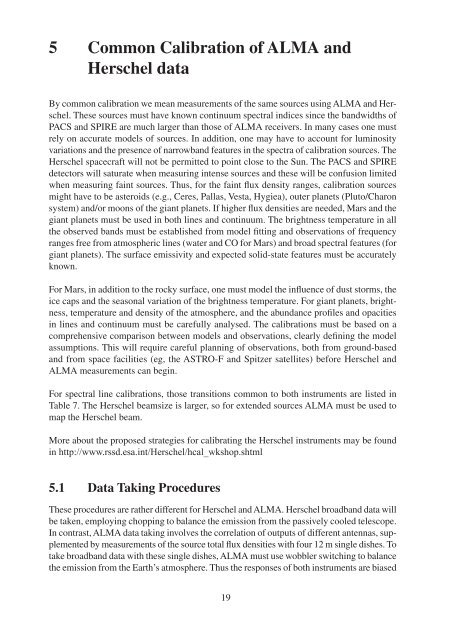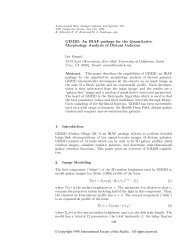4 Comparison of the ALMA and Herschel - ESO
4 Comparison of the ALMA and Herschel - ESO
4 Comparison of the ALMA and Herschel - ESO
You also want an ePaper? Increase the reach of your titles
YUMPU automatically turns print PDFs into web optimized ePapers that Google loves.
5 Common Calibration <strong>of</strong> <strong>ALMA</strong> <strong>and</strong><br />
<strong>Herschel</strong> data<br />
By common calibration we mean measurements <strong>of</strong> <strong>the</strong> same sources using <strong>ALMA</strong> <strong>and</strong> <strong>Herschel</strong>.<br />
These sources must have known continuum spectral indices since <strong>the</strong> b<strong>and</strong>widths <strong>of</strong><br />
PACS <strong>and</strong> SPIRE are much larger than those <strong>of</strong> <strong>ALMA</strong> receivers. In many cases one must<br />
rely on accurate models <strong>of</strong> sources. In addition, one may have to account for luminosity<br />
variations <strong>and</strong> <strong>the</strong> presence <strong>of</strong> narrowb<strong>and</strong> features in <strong>the</strong> spectra <strong>of</strong> calibration sources. The<br />
<strong>Herschel</strong> spacecraft will not be permitted to point close to <strong>the</strong> Sun. The PACS <strong>and</strong> SPIRE<br />
detectors will saturate when measuring intense sources <strong>and</strong> <strong>the</strong>se will be confusion limited<br />
when measuring faint sources. Thus, for <strong>the</strong> faint flux density ranges, calibration sources<br />
might have to be asteroids (e.g., Ceres, Pallas, Vesta, Hygiea), outer planets (Pluto/Charon<br />
system) <strong>and</strong>/or moons <strong>of</strong> <strong>the</strong> giant planets. If higher flux densities are needed, Mars <strong>and</strong> <strong>the</strong><br />
giant planets must be used in both lines <strong>and</strong> continuum. The brightness temperature in all<br />
<strong>the</strong> observed b<strong>and</strong>s must be established from model fitting <strong>and</strong> observations <strong>of</strong> frequency<br />
ranges free from atmospheric lines (water <strong>and</strong> CO for Mars) <strong>and</strong> broad spectral features (for<br />
giant planets). The surface emissivity <strong>and</strong> expected solid-state features must be accurately<br />
known.<br />
For Mars, in addition to <strong>the</strong> rocky surface, one must model <strong>the</strong> influence <strong>of</strong> dust storms, <strong>the</strong><br />
ice caps <strong>and</strong> <strong>the</strong> seasonal variation <strong>of</strong> <strong>the</strong> brightness temperature. For giant planets, brightness,<br />
temperature <strong>and</strong> density <strong>of</strong> <strong>the</strong> atmosphere, <strong>and</strong> <strong>the</strong> abundance pr<strong>of</strong>iles <strong>and</strong> opacities<br />
in lines <strong>and</strong> continuum must be carefully analysed. The calibrations must be based on a<br />
comprehensive comparison between models <strong>and</strong> observations, clearly defining <strong>the</strong> model<br />
assumptions. This will require careful planning <strong>of</strong> observations, both from ground-based<br />
<strong>and</strong> from space facilities (eg, <strong>the</strong> ASTRO-F <strong>and</strong> Spitzer satellites) before <strong>Herschel</strong> <strong>and</strong><br />
<strong>ALMA</strong> measurements can begin.<br />
For spectral line calibrations, those transitions common to both instruments are listed in<br />
Table 7. The <strong>Herschel</strong> beamsize is larger, so for extended sources <strong>ALMA</strong> must be used to<br />
map <strong>the</strong> <strong>Herschel</strong> beam.<br />
More about <strong>the</strong> proposed strategies for calibrating <strong>the</strong> <strong>Herschel</strong> instruments may be found<br />
in http://www.rssd.esa.int/<strong>Herschel</strong>/hcal_wkshop.shtml<br />
5.1 Data Taking Procedures<br />
These procedures are ra<strong>the</strong>r different for <strong>Herschel</strong> <strong>and</strong> <strong>ALMA</strong>. <strong>Herschel</strong> broadb<strong>and</strong> data will<br />
be taken, employing chopping to balance <strong>the</strong> emission from <strong>the</strong> passively cooled tele scope.<br />
In contrast, <strong>ALMA</strong> data taking involves <strong>the</strong> correlation <strong>of</strong> outputs <strong>of</strong> different antennas, supplemented<br />
by measurements <strong>of</strong> <strong>the</strong> source total flux densities with four 12 m single dishes. To<br />
take broadb<strong>and</strong> data with <strong>the</strong>se single dishes, <strong>ALMA</strong> must use wobbler switching to balance<br />
<strong>the</strong> emission from <strong>the</strong> Earth’s atmosphere. Thus <strong>the</strong> responses <strong>of</strong> both instruments are biased<br />
19




